|
NorthernTel | Photo Highlights | Narrative Highlights | |
|||
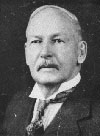 |
Thomas McCamus - "A visionary and co-founder of Temiskaming Telephone Co." | ||
|
|
|||
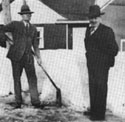 |
1908 - "In an extraordinary expression of confidence Percy Craven was appointed manager of all accounts, superintending of office staff, operators, agencies and the transaction of all business with municipalities and customers." Shown here is Percy Craven (right) and R.R. Woods. | ||
|
|
|||
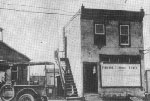 |
The Porcupine Telephones Lines Limited was purchased by Northern Telephone in 1928 | ||
|
|
|||
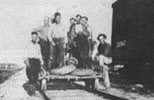 |
Construction crew building line between Kapuskasing - Hearst in 1929 | ||
|
|
|||
 |
1934 - Kirkland Lake Office Building | ||
|
|
|||

June 12, 1937 - Northern Telephone's 1st Annual Picnic, Culver Park. "Every year there was a company picnic and dinner and sometimes at least one punch bowl was surreptitiously spiked, and great efforts made to keep Mr. Craven unaware." |
|||
|
|
|||
 |
Female employees in the early years usually worked as operators and clerks. This photograph shows a group of female employees at the New Liskeard Head Office. Back row, from left, are: J. MacDougall, J. Craven, G. Brown, M. Swayne and M. Edwards; middle row, from left, J. Stewart, E. Pringle, A. Moore, L. Melisek and W. Barker; Front row, from left, F. Baker and R. Craven | ||
|
|
|||
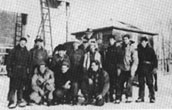 |
"The 30's were demanding times for the men stringing lines through the bush, and installing telephones as fast as the towns grew." Shown here is a Timmins Line Crew from 1937. | ||
|
|
|||
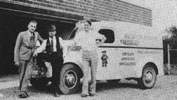 |
In 1937, Don McKelvie, the future general manager, president and chairman of the company, and son of co-founder Angus McKelvie, joined Northern Telephone. Shown here, from left, are: Alex Brown, Arnold White and Don McKelvie. | ||
|
|
|||
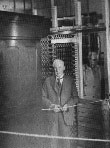 |
1940 - Tom McCamus cuts over Magneto to Common Battery at New Liskeard office as co-founder Angus McKelvie looks on. | ||
|
|
|||
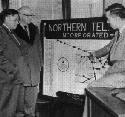 |
At a Timmins Open House in 1955, P. Ryan discusses the growth of Northern Telephone's systems with J. Wilder and Dr. McClinton. | ||
|
|
|||
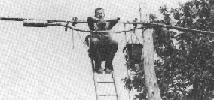
Cable splicer, Jack Alderdice taking a break in New Liskeard, July of '64 |
|||
|
|
|||
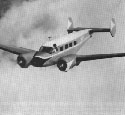 |
In March of 1963, Northern Telephone acquired this aircraft. Operating out of Earlton, the 7 passenger aircraft enabled head office personnel to cover the vast areas of Northern Ontario and Northern Quebec to which it provided telephone service | ||
|
|
|||
 |
"By 1964 Northern Telephone was recognized as a major power in the Canadian communications industry." Shown here is the IBM 1440 computer in New Liskeard in 1966. | ||
|
|
|||
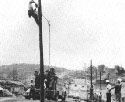 |
"The Cobalt fire of May, 1977 provided Northern Telephone with another experience in quickly restoring communications which may have proven useful when the company faced its great fire a couple of years later" | ||
|
|
|||

Just a month after the Cobalt disaster on June 25, 1977, the company celebrated a more positive event with an open house at the newly finished Northern Telephone Centre at Timmins. |
|||
|
|
|||
 |
1979 - Alex Brown (left) and Norm Currie share conversation at one of the many Northern Telephone functions. | ||
|
|
|||
|
December 13, 1979 - The New Liskeard Head Office is destroyed by fire, providing some of the most hectic hours in the company's history. This proved to be a time when a number of employees acted on their own initiative and prevented an even greater loss by dealing with the emergency without waiting for orders. | ||
|
|
|||
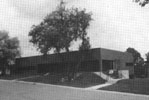 |
The New McKelvie Building. "Northern Telephone entered the 80's with a new head office that would have astonished the directors who in 1905 rented their first accommodation above Mr. Abraham's stationary store for $10 a month." | ||
|
|
|||
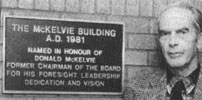
1981 - Don McKelvie |
|||
|
|
|||
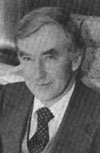 |
Murray W. Cooper began his Northern Telephone career in 1964 as assistant secretary treasurer. After a few senior appointments, he was appointed President and General Manger in 1978, a director in 1982 and then President and Chief Executive Officer in 1983. He lead the company until 1993, and later served as Vice-Chairman of the Board of Directors before retiring. | ||
|
|
|||
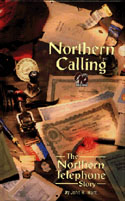 |
For an in depth view of the History of Northern Telephone read "Northern Calling, the Northern Telephone Story" by John R. Hunt | ||
|
|
|||
|
|
|||
|
The Temiskaming Telephone Company Limited was incorporated April 5, 1905 in New Liskeard. Originally founded to provide telephone service in New Liskeard and other parts of the Temiskaming District, the company used only its name, usually in a script style, as a means of identification. |
|||
 |
A new corporate identity, more indicative of the large territory served by the Company came into being in 1928 when the Temiskaming Telephone Company Limited became Northern Telephone Limited. In 1944, a corporate logo depicting a telephone pole and wires against a background of hills and forest, was developed. | ||
|
|
In 1960, the word "Company" was dropped and a different print style was used on all documents bearing the Northern Telephone Limited name. The corporate logo changed in 1964 to incorporate the stylized "N" and telephone set. The logo is still in use today. | ||
|
|
January 15, 2003
|
||
|
|
|||
|
- The Company's first dial conversion is completed at the Cobalt exchange. 19 Voice Mail is introduced in Timmins. Digital switching is installed in Swastika. Integrated Voice Messaging Service (IVMS) is launched. 1- Northern Telephone's NT.NET joins the national Sympatico? Internet Service. The first authorized Northern Telephone dealer is established at a New Liskeard retail business. 1- A Network Support and Maintenance Centre is opened to provide 7 day, 24 hour service for customers. The One Switch transition is completed in Timmins. Northern Telephone launches its new website, providing information and on-line order capabilities. 1- Customers in Matheson, Iroquois Falls, Virginiatown, Larder Lake and Opishing all receive digital switching upgrades. Fax to e-mal service and High Speed Internet using ADSL and ATM technology are introduced. The first fibre ring from the Tri-Towns north to Kapuskasing is completed and NorTel Mobility extends cellular service to Larder Lake. 2- Northern Telephone embarks on Phase 1 of a $6.4-million program to eliminate customer party lines throughout its serving area. The communities of Calstock, Cobalt, Connaught, Iroquois Falls, Kamiskotia, Kirkland Lake, Larder Lake, Latchford, Moonbeam, Ramore, South Porcupine and Swastika are upgraded to individual line service. Digital switching technology is installed in Elk Lake. NorthernTel sells its Cochrane assets to the Cochrane Public Utilities Commission. The upgrade to individual line service in Earlton, Englehart, Matheson, Mattice, Opasatika, Opishing, Abitibi Canyon, Detour Lake, Gowganda, Timmins and Virginiatown, becomes the standard level of service across NorthernTel territory. 2003 - Northern Telephone's name officially changes to NorthernTel and NorTel Mobility changes to NorthernTel Mobility. New digital cellular towers are installed at South Porcupine, Kenogamissi, Hearst and Cochrane. The Northern Ontario Heritage Fund commits $5 million and NorthernTel invests a further $3 million to begin a cellular expansion project with NEOnet. 2007 – In February 2007, NorthernTel becomes part of the Bell Aliant Regional Communications group, an income trust created in 2006 and controlled by Bell Canada. Bell Aliant is one of North America’s largest regional communications providers and serves customers in New Brunswick, Newfoundland and Labrador, Nova Scotia, and Prince Edward Island from its Halifax headquarters May 1, 2009, a closer link is created with Bell Aliant with the descriptor "a division of Bell Aliant " added to the NorthernTel logo.
2014 - November 3, 2014, BCE announced the completion of its privatization of Bell Aliant and the integration of its Atlantic Canada affiliate into BCE's national operations. As a member of Bell Aliant, NorthernTel integrated the BCE family. The mention “a division of Bell Aliant” was removed from the logo at the same time.
|
|||



